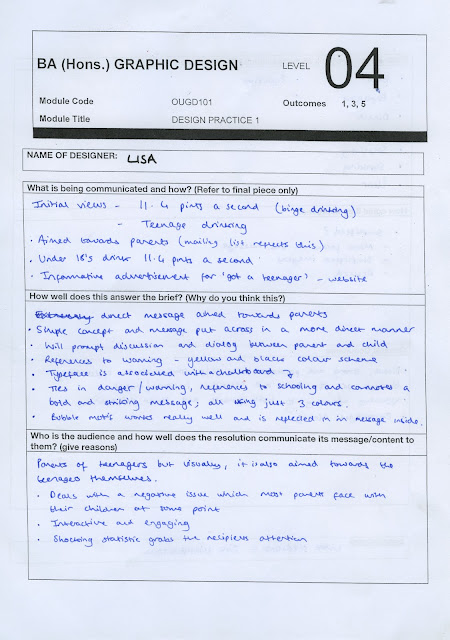BA (Hons.) GRAPHIC DESIGN | LEVEL | 04 | |
Module Code | OUGD101 | ||
Module Title | DESIGN PRINCIPLES | ||
END OF MODULE SELF-EVALUATION |
NAME | Lisa Whitaker | BLOG. ADDRESS | http://l-whitaker1013.blogspot.com/ |
1. What skills have you developed through this module and how effectively do you think you have applied them? | |||||
· More aware of colour and the science underlying colour. Colour in terms of RGB for screen and CMYK for print. The Pantone library, colour swatches in Photoshop and Illustrator. · Font terminology, X-height, stroke, serif and san serif. Starting to think about which fonts communicate the message most effectively and why · Setting up and updating a Blog. I am managing to blog regularly however need to make more visual as still do a lot of writing to explain myself. · Illustrator skills – the pen tool, pathfinder and tracing. Applied this to creating my typeface Lewis and also the Illustrator brief reasonably well. · The crit groups are providing skills and confidence to look at work beyond just liking or disliking it. I can see the importance of this skill for the whole group to grow as designers. | |||||
2. What approaches to/methods of research have you developed and how have they informed your design development process? | |||||
Time constraints have led to a lot of the research being sourced online however the library, if difficult to navigate, has been useful. The library research tends to be more relevant and stronger in the design development process e.g. the Yann Legendre posters from the Graphic Posters annual 08/09 in the No News brief. Websites like D&AD and Behance are useful for inspiration and also often provided paths to other research, which otherwise may not have found. The No News research conducted from the Guardian article about underage drinking statistics also proved to be like the start of a huge web of information. This lead me to the viral advertising on underage drinking performed by comedian Bill Bailey. The hard-hitting messages certainly were a reality check in terms of the audience and subject. Up to that point I felt to be taking the moral high ground. | |||||
3. What strengths can you identify in your work and how have/will you capitalise on these? | |||||
The main strength in my work has been pinning down an idea/concept quite early on. For example I was pleased with the pint glass/straw imagery in the No news – interpretation. On the No news- delivery brief, the ‘wrap your kids in bubble wrap’ metaphor was also strong and relatively easy to translate visually. | |||||
4. What weaknesses can you identify in your work and how will you address these more fully? | |||||
The execution of the ideas into reality is sometimes frustrating in terms of my current software skills. Also due to time constraints I have tended to use Photoshop, which I am stronger in when Illustrator would have been a better tool. Whenever I come across a problem I usually search for a tutorial or ask one of the Mac suite instructors. For example I did not know how to get a dotted line around the teenager silhouette but Mike explained how to do this in Illustrator. I now have a better understanding of Vector images and rastorised images. The only problem with this approach is my skills are limited to grow in line with the demand of each brief. There is a huge black hole of software I am not utilising. I plan to try to get more to grips with Illustrator between now and January by speaking with Michael or Simon for the best approach. | |||||
5. Identify five things that you will do differently next time and what do you expect to gain from doing these? | |||||
1. Keep a more visual sketch book and /or design sheets – Design development more structured and more interesting to reflect on 2. Try to consider a broader range of solutions before selecting. Due to the tight deadlines I tend to go with the first idea. The outcome can only be stronger by considering more solutions early on. 3. Think beyond Photoshop. More varied solutions 4. Have the confidence to think beyond software and go back to drawing/painting to get a more hand crafted solution. 5. Keep up with the background reading including Graphic design journals such as Creative Review. Keep my work current and informed. | |||||
6.How would you grade yourself on the following areas: (please indicate using an ‘x’) 5= excellent, 4 = very good, 3 = good, 2 = average, 1 = poor | |||||
1 | 2 | 3 | 4 | 5 | |
Attendance | X | ||||
Punctuality | X | ||||
Motivation | X | ||||
Commitment | X | ||||
Quantity of work produced | X | ||||
Quality of work produced | X | ||||
Contribution to the group | X | ||||
The evaluation of your work is an important part of the assessment criteria and represent s a percentage of the overall grade. It is essential that you give yourself enough time to complete your written evaluation fully and with appropriate depth and level of self-reflection. If you have any questions relating to the self evaluation process speak to a member of staff as soon as possible. | |||||



















